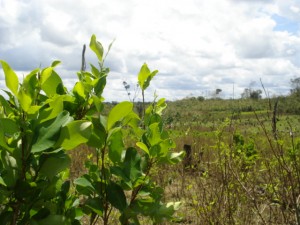
Coca re-growth in a fumigated field. Guaviare 2009. Photo: Damon Barrett
The Colombian departments of Cordoba, Guaviare, and Cauca saw significant increases in coca cultivation in 2009, although national production dropped 16%, El Tiempo reported Tuesday.
According to a forthcoming United Nations report, coca production in the northern department of Cordoba rose from 1,710 to 2,700 hectares, a 58% increase, after declining the previous year.
In the southern department of Guaviare, coca production rose from 6,629 to 8,300 hectares during the year, a 25% increase, returning to its 2005 level of production.
Meanwhile, in the south-western department of Cauca, where the FARC have been very active in the last year, coca production rose from 5,400 to 6,100 hectares in 2009, a 13% increase. The province also saw an increase of over 1,000 hectares between 2007 and 2008.
Overall the report, which was compiled using data submitted by Colombian authorities in April, found that Colombia reduced its national coca production from 81,000 hectares in 2008 to 68,025 in 2009, a 16% drop.
The department with the highest production, according to the report, remains Nariño, which despite showing a drop of 3,000 hectares, farmed 16,800 hectares of coca.
According to Colombia's anti-narcotics police, there are various reasons for the rise in coca production in the three "losing" departments.
In Cordoba, they explain, emerging gangs such as the one led by Juan de Dios Usuga, alias "Giovanni," an heir to notorious drug kingpin "Don Mario," and the use of Paramillo Natural Park, where authorities are not allowed to conduct arial fumigation, have led to a rise in the cultivation of coca.
Meanwhile, in the departments of Cauca and Guaviare, the police claim that legal restriction that have prevented them from entering indigenous territories have allowed gangs to exploit these territories to freely cultivate coca.
The areas that showed the greatest improvements were the department of Putumayo, dropping from 9,600 to 5,300 hectares, followed by Valle del Cauca (2,089 to 900), Choco (2,794 to 950), Santander (1,791 to 950), Vaupes (557 to 350), Amazonas (836 to 277) and Magdalena (391 to 150).
Story originally published in Colombia Reports on June 8, 2010.
